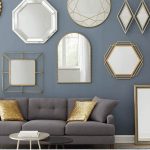Feng Shui, a science based philosophy, allows human beings to harmonize energies by adjusting various furniture, fixtures and also through addition and subtraction of objects within the habitats. It also offers a creative span to usher in good “Chi” in the form of “Colors”.
Feng Shui’s literal meaning is “Wind Water “. However, this art is made up of five essential elements – wood, fire, earth, metal and water. Interestingly, each of these elements has additional subset – color. In short each element in Feng Shui resembles certain color/s and therefore needs equal attention while sprucing up your house.
Have you ever felt uneasy in your own bedroom? Maybe experienced goose bumps while stepping into a certain section of your house? If you have, you are not the only one. Hundreds and thousands of people across the continents face this dilemma and yet continue to adapt and adjust.
So, what is the reason for this uneasiness and that too within your own, cherished home? The answer is clashes of energies or the overwhelming supremacy of Yin over Yang. This generally happens due to wrong choice of color for a particular element. The Bagua energy map clearly spells out complementing colors for all the five elements. Applying these principles to your house can invigorate depressing and negative sections of your house. It not only balances the energies but also plays a crucial role in improving mood, good luck and thereby help achieve financial and life goals.
Although, it may seem like a casual chore, choosing the right color can be confusing for those who are new to Feng Shui. Broadly speaking, this art and science is based on Bagua chart, which consists of various positions, their relative elements and of course the colors associated with them. Mentioned below are some of the typical steps involved in choosing the right Feng Shui color. However, it is highly recommended that you hire a professional for expert guidance.
- Once you have the Bagua chart in your hand, locate the sector in which the concerned room resides. You can either use a compass or the blueprint of your residence. This will offer pin point direction and reduce the scope for error.
- Once you find out the sector, the next step is to find the element associated with it. For example, if you are painting your bedroom and this section of the house is located in the Southeast cardinal direction, then its complementing element is wood.
- Once you know the related element, refer the chart once again and find the matching colors. Let us take the above example once again. If wood is the corresponding element then its complementing colors would be different shades of green and blue. Choose the shade which offers maximum soothing effect and you are done.
Here are the five elements and their corresponding colors –
- Wood – Greens and blue, and the life attributes include family & wealth.
- Fire – Red, pink or orange, and the life attribute includes passion.
- Earth – Brown and yellow, and its relative life virtues are health, knowledge and partnerships.
- Water – Black, while its life characteristics include career.
- Metal – White, gray, metallic and its associated life values are children, and helpful people.
However, and because each element supports quite a few colors it may become difficult to select the most appropriate one. For example, if your child’s room is located in the Southwest direction, which incidentally is the bastion of earth element, its complementing colors brown and yellow can be tricky options.
In such a scenario, choosing the one which enhances your child’s outlook, his / her mental growth and overall development needs a logical approach. Remember, children feel comfortable in the company of lighter shades. De-cluttering is an additional chore which you need to perform along with color selection. Extremely vibrant colors can actually be harmful, diverting your kid’s focus.
As a rule of thumb, each section of your house should be painted in different color depending on the above mentioned factors. Moreover, solid colors need to be balanced to achieve the targeted goal. This simply means equilibrating the Yin and Yang factors. While the former is associated with negative and dark attributes, the latter with brighter and positive virtues. By diluting the basic color or using multiple shades, you can create a perfect shade that resonates with harmony – an everlasting balance of various energies.
It is always a good idea to first study the Bagua chart before initiating the remodeling task. Feng Shui in some ways is unforgiving, which means incorrect use of colors can actually disturb the current harmonious atmosphere of your house and cause more problems. Study the chart, its elements and colors associated with it carefully. There is yet another aspect which you need to look into – the life areas. Every cardinal direction supports a string of life aspects such as wealth, happiness, health, career, helpful people, etc. You also need to take them into consideration.
At any point, during the remodeling chore, you feel lost or unhappy with the results you should seek professional advice and rectify the mistakes immediately. Get in touch with a knowledgeable Feng Shui entity and build a rewarding, healthy and prosperous habitat for you and your family.
Summation –
Feng Shui is not a playground for experiments. If miscalculated, its long term repercussions can be disastrous, and therefore a holistic approach is required. Instead of venturing into a misadventure seek help from a professional Feng Shui practitioner.



